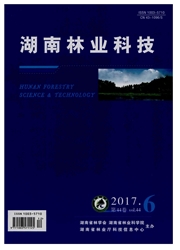

 中文摘要:
中文摘要:
洞庭湖区作为中国重要的商品粮基地,水稻种植面积的变化对国家粮食安全有重要的影响,准确获取水稻面积及其变化显得十分重要。为解决数据缺失问题,该文利用STARFM(spatial and temporal adaptive reflectance fusion model)模型融合高时间分辨率的MODIS数据与中等空间分辨率的Landsat数据,得到时序Landsat NDVI数据,并利用时序Landsat NDVI数据对水稻种植面积进行提取。结果显示,该方法能够有效地提取水稻种植面积,总体分类精度94.52%,Kappa系数为0.9128。水稻分布几乎覆盖整个研究区,水稻种植总面积达7.88×10^5hm^2。双季稻种植面积为7.75×10^5hm^2,主要集中于湖区北部及西北部,且分布较连续。一季稻种植面积为1.3×10^4hm^2,分布相对零散,有小范围集中于湖区中部及西北部。
 英文摘要:
英文摘要:
The Dongting Lake area is one of the important commodity grain bases in the middle and lower reaches of Yangtze River, China, so we selected the Dongting Lake area as an example to extract the paddy area using Landsat data. But it was hard to get the time series Landsat data of the study area due to the rainy weather and return cycle of the satellite. In order to solve the problem of data missing in mapping paddy fields, we used STARFM(spatial and temporal adaptive reflectance fusion model) algorithm to blend MODIS and Landsat data, and got the high-frequency temporal information from MODIS and high-resolution spatial information from Landsat. Then the Savitzky-Golay(S-G), Gaussian and Double logistic filter were used to smooth the time series Landsat NDVI(normalized difference vegetation index) data. Through the comparative analysis, we found that the overall fidelity of Savitzky-Golay was the best. On one hand, the correlation coefficient between original NDVI value and fitting value was higher than the other 2 methods which were used to smooth the time series Landsat NDVI data. On the other hand, the root mean square error was smaller than the other 2 filters for land cover types except the forest. With the phonological calendar of crops and the computation of Jeffries-Matsushita distance(J-M), and through selecting validation data randomly throughout the study area for many times, we got the best J-M distance and the optimal Landsat NDVI data combination, and the optimal Landsat NDVI data combination was the 145 ^th, 193 ^rd, 241^ st, 273^ rd and 305 ^th day. Support vector machine was used to map paddy area of study area next. Results showed that this method could map paddy fields effectively, and get a high overall precision of 94.52% with the Kappa coefficient of 0.9128. Producer's accuracies(PA) for double cropping rice, single season rice, cotton and forest was over 90%. The user's accuracies(UA) were over 90% except single season rice(88.42%), because 109 single season pi
 同期刊论文项目
同期刊论文项目
 同项目期刊论文
同项目期刊论文
 期刊信息
期刊信息
